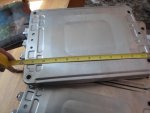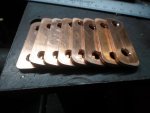Functional Artist
Well-known member
I have been researching the re-use of individual "Leaf" (Lithium battery) modules 
...ones that have been, removed from Nissan Leaf (cars) vehicles
Here is some info on them (it's kinda long but, if interested, it has lots of good info)
https://www.youtube.com/watch?v=vYQJatWpBXY&t=20s
I currently have a 48V 45AH pack, out of a Chevy Volt, on my El Moto
http://www.diygokarts.com/vb/showthread.php?t=37062
But, being that my "Volt" battery pack is only 12S (45V nominal), the top charge voltage is only ~49.8V
So currently, my top speed is only ~35MPH
...but, I must say, that it get's there really, really quick
…plus, with it's 45AH capacity, my range is only ~25 miles
So, it looks like, if I move up to/use (7) of these 7.5V Leaf modules, which would "actually" be 14S (52.5V nominal)
...it would have a top charge voltage of ~54V (which should increase my top speed a bit)
...& with it's 66AH capacity (my range should increase a bit too)
Maybe something like this (~$475.00)
https://www.ebay.com/itm/Solar-RV-Ni...1&isGTR=1#shId
It's (7) individual Leaf cells
…including a BMS
...plus a printed circuit board (for connecting the BMS)
* But, while researching, I've come across some negative (-) info about these cells (like loosing capacity)
https://www.mynissanleaf.com/viewtopic.php?f=27&t=26662
This is very concerning, when contemplating buying these type of cells
...especially, pre-used ones
So, I am interested in any opinion &/or info on re-using these Leaf cells
…& also, this printed circuit board, BMS connection concept (in eBay ad)

...ones that have been, removed from Nissan Leaf (cars) vehicles
Here is some info on them (it's kinda long but, if interested, it has lots of good info)
https://www.youtube.com/watch?v=vYQJatWpBXY&t=20s
I currently have a 48V 45AH pack, out of a Chevy Volt, on my El Moto
http://www.diygokarts.com/vb/showthread.php?t=37062
But, being that my "Volt" battery pack is only 12S (45V nominal), the top charge voltage is only ~49.8V
So currently, my top speed is only ~35MPH
...but, I must say, that it get's there really, really quick

…plus, with it's 45AH capacity, my range is only ~25 miles

So, it looks like, if I move up to/use (7) of these 7.5V Leaf modules, which would "actually" be 14S (52.5V nominal)
...it would have a top charge voltage of ~54V (which should increase my top speed a bit)
...& with it's 66AH capacity (my range should increase a bit too)

Maybe something like this (~$475.00)
https://www.ebay.com/itm/Solar-RV-Ni...1&isGTR=1#shId
It's (7) individual Leaf cells
…including a BMS
...plus a printed circuit board (for connecting the BMS)
* But, while researching, I've come across some negative (-) info about these cells (like loosing capacity)
https://www.mynissanleaf.com/viewtopic.php?f=27&t=26662
This is very concerning, when contemplating buying these type of cells
...especially, pre-used ones
So, I am interested in any opinion &/or info on re-using these Leaf cells
…& also, this printed circuit board, BMS connection concept (in eBay ad)




























